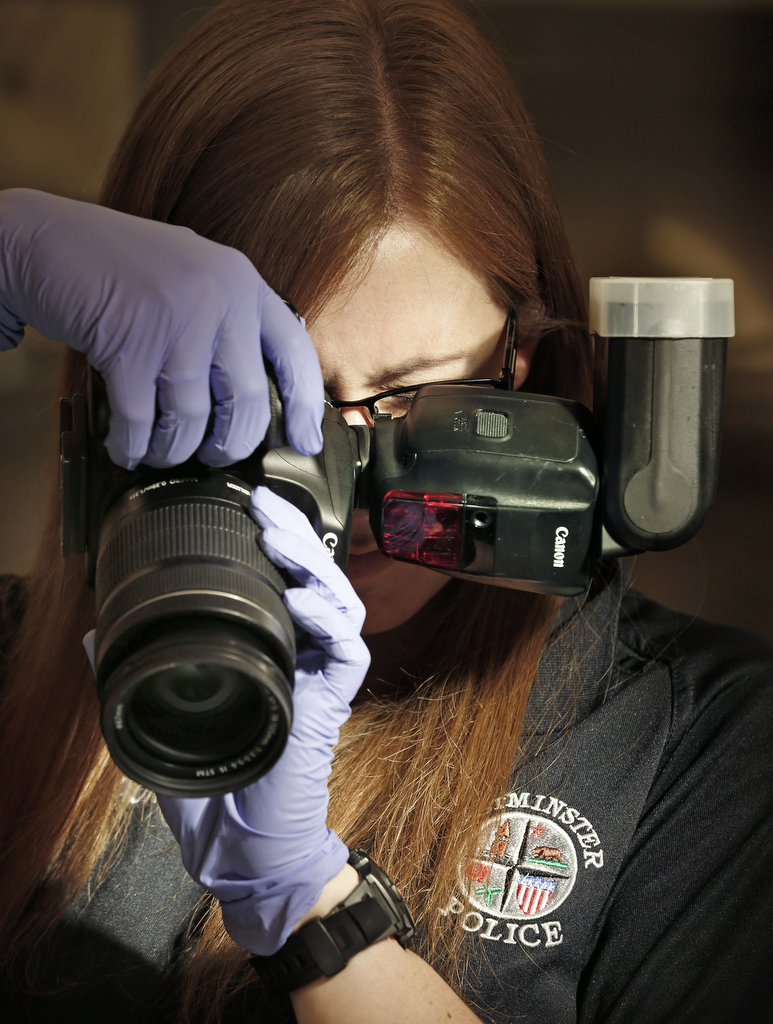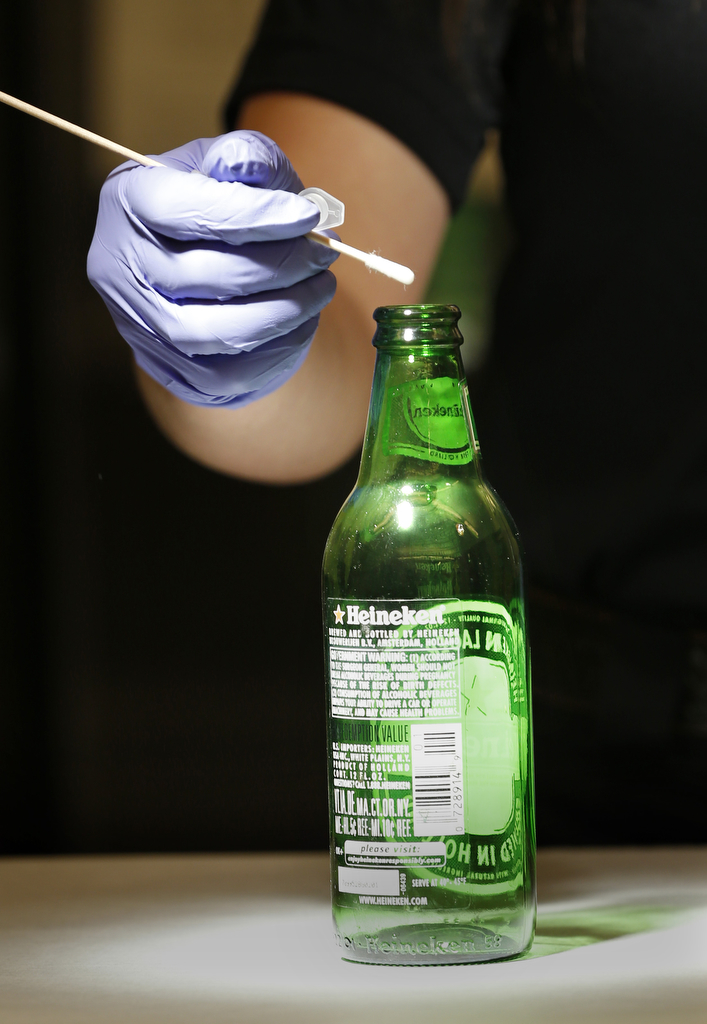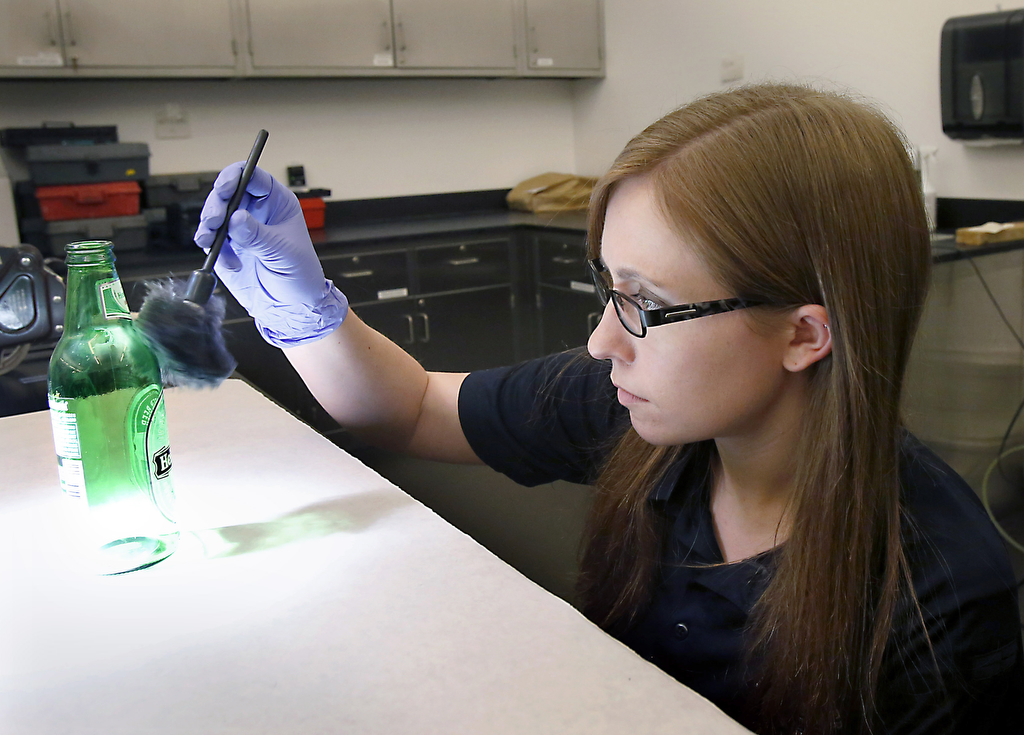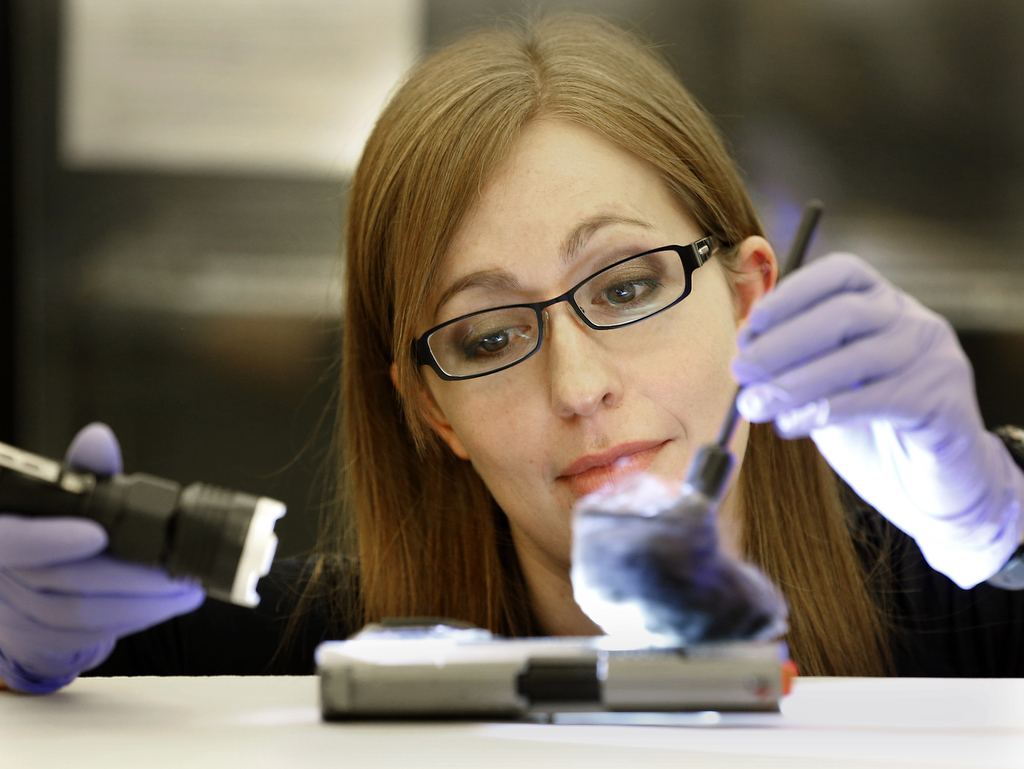She can’t watch because they get it so wrong.
Westminster Police Forensic Services Technician Nicole Dixon steers clear from any CSI television shows because she inevitably ends up frustrated.
The glamorization of her job by Hollywood is a loose interpretation of the reality she sees every day in her state-of-the-art lab that, ironically, looks straight out of a crime drama.
The No. 1 thing Hollywood gets wrong in conveying how CSI works?
“The heels. Nobody wears heels,” Dixon joked. “I don’t get a gun and a sexy suit. I wear baggy cargo pants.”
In all seriousness, Dixon said, the way her job works just isn’t accurately portrayed.
“It’s a much lengthier process than what they do on TV,” she said. “They show one person doing everything and that’s not how it is. CSI is split up into different jobs with a team of people.”

Nicole Dixon, Forensic Services Technician for the Westminster Police Department demonstrates how she would use a swab to collect evidence.
Photo by Christine Cotter/Behind the Badge OC.
She’s recently added another show on her personal “do not watch list,” but for different reasons.
FX’s popular 10-episode miniseries, “The People v. O.J. Simpson,” re-hashes the infamous case that today serves as a textbook example of what police should not do at a crime scene.
“I can’t do it,” she said of watching the show. “It was like (the police) tried to make a movie of how to do everything wrong.”
Dixon quickly rattled off a list of no-no’s: Covering a body before evidence is collected, walking through a trail of bloody footprints and storing a vial of blood in a shirt pocket while running personal errands.
Packaging evidence in plastic bags and leaving it in the heat is also on the list of what not to do, Dixon said.
“If you package something in plastic, air can’t get through,” Dixon said. “Moisture builds, then you get bacteria. In the case of the leather glove, it started shrinking.
“That case is the first one we go over (in forensic training).”
Television, even the shows based on real life like the new FX series, is the problem with getting the public to understand what forensic technicians do day in and day out, Dixon said.
Although it’s nothing like the world created for the small screen, forensics is often what police need to build their cases and make them stronger.
If not handled correctly, evidence also can be the difference between a successful prosecution or acquittal.
“You have to be super confident when you’re doing something the first time that you’re doing something the right way,” Dixon said. “If you don’t, you won’t be able to get anything from (the evidence) and it’s useless.”
Dixon went for a career in forensics a little more than two years ago because she was interested in law enforcement, but didn’t want to be a cop.
“This job just had everything I wanted,” she said. “I’m very detail-oriented so I felt like this would be a really good fit for me.”

Nicole Dixon, Forensic Services Technician for the Westminster Police Department demonstrates how she searches for DNA evidence on a handgun.
Photo by Christine Cotter/Behind the Badge OC.
Growing up in Huntington Beach, Dixon said she was into “nerdy stuff” — mostly science and reading.
The shy Edison High School graduate would read the newspaper every day and pepper her parents with questions about the stories she’d come across.
If a crime happened, she wanted to know the details. When a great arrest was reported, she wanted to know how the detectives figured it out.
“Ever since I was a kid, I wanted to know this kind of stuff so I researched some of the behind-the-scenes law enforcement work,” Dixon said. “It’s not a job that everyone is good at, but it’s one I feel I can really bring something to the field.”
The 22-year-old has an associate’s degree in forensics and is currently working toward her bachelor’s degree in forensic psychology.
She also is certified by the California Commission on Peace Officer Standards and Training as a field evidence technician.
Dixon was hired by the Westminster PD a little more than two years ago. She was paired with an experienced technician to show her the ropes.
There is a lot to take in, Dixon quickly learned.
Technicians must know what to take from a scene, how to document it all and properly test it at the lab.
Protocols on top of protocols must be committed to memory so every piece of evidence, whether it’s a rock, a piece of clothing or a water bottle, is handled correctly.
Dixon also has to be well-versed in chemistry to understand how to pull critical evidence off a variety of surfaces and to know which chemicals could potentially compromise her work.
“There are a lot of cardinal rules when it comes to handling evidence,” Dixon said. “You can’t take shortcuts.”
But a forensic tech’s most underrated attribute, Dixon said, is their expert photography skills.
“Anyone can dust and swab, but not everyone can take a good photo,” she said. “Once a crime scene is gone, it’s gone. With photos and diagrams, we can revisit the scene.”

Photography skills are some of the most important attributed forensic technicians bring to a police department. Taking accurate photographs helps detectives reference the scene throughout their investigation.
Photo by Christine Cotter
Although her job is without the glamour some might expect if basing those expectations off a favorite prime-time show, it has its drama.
The worst she has seen so far was an attempted murder case after a husband tried to kill his wife while their children were home.
That gruesome scene was especially hard to stomach, Dixon said.
“That was the first time I had ever seen anything like that,” Dixon said. “It was hard, not just for me, but I think for everyone who responded. Since then, the department has continued to help the family in different ways.”
The job even comes with moments of comic relief, as most good television shows do.
Like the time she leaned over to collect a blood sample after the August 2014 Tick Tock Watches robbery and split her pants, which was caught on camera and even made the evening news.
(And while forensic techs don’t wear heels, they apparently do wear Batman underwear.)
“It was a major station,” Dixon said. “I saved that video so I can show it to my kids one day. It’s so embarrassing.”
Those Hollywood-worthy moments are few and far between, though, but Dixon is good with that because it’s not why she got into the job.
“It is nothing like television whatsoever, but it is so rewarding,” she said. “I would never want bad things to happen to anyone but if they do, I want to be there to help.
“Plus, I get a cool lab.”

Nicole Dixon, Forensic Services Technician for the Westminster Police Department uses various methods to collect evidence, including swabbing items, as shown here.
Photo by Christine Cotter/Behind the Badge OC
 Behind the Badge
Behind the Badge





